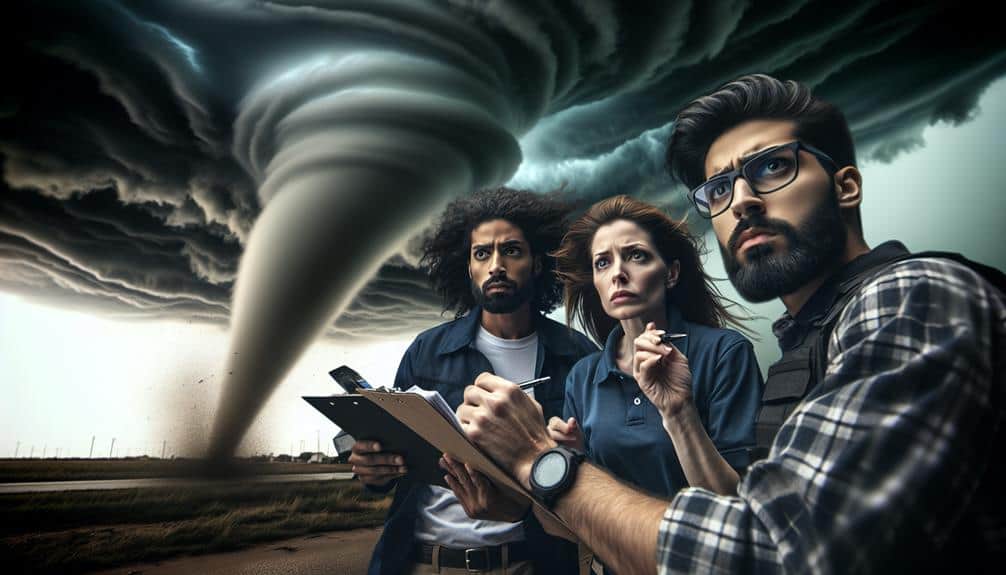Exploring storm chasing ethics involves three key considerations. First, we must prioritize the well-being of local communities by minimizing disruptions, respecting privacy, and demonstrating cultural sensitivity. Second, we balance public safety by rigorously analyzing meteorological data, utilizing advanced technology, and maintaining clear safety protocols while constantly communicating with emergency services. Lastly, our media responsibility demands we uphold journalistic integrity by grounding our reports in verified data and offering actionable insights. Each of these considerations guarantees we conduct our activities ethically and responsibly. For more insights into implementing these ethical practices, stay with us.
Key Points
- Prioritize the well-being and privacy of local communities while minimizing disruptions.
- Utilize data-driven approaches and advanced technology to ensure accurate and safe storm chasing.
- Engage with local authorities and emergency services to communicate critical information effectively.
- Focus on factual, objective reporting, and verify sources to uphold journalistic integrity.
Respecting Local Communities
When storm chasing, we must prioritize the well-being of local communities by minimizing disruptions and respecting their privacy. Community engagement is critical; it guarantees that our presence doesn't become a burden. We need to understand that our actions can impact not just the environment but also the daily lives of residents. By actively seeking input from local officials and residents, we can tailor our activities to be less intrusive.
Utilizing data-driven approaches to identify less populated areas for observation can reduce potential disturbances. For example, spatial analysis tools can help us pinpoint locations where our activities will have minimal impact. Additionally, respecting local customs and traditions demonstrates cultural sensitivity. Each community has unique practices and values that we should honor to foster goodwill and mutual respect.
We must also be mindful of our communication. Sharing information about our activities and objectives helps alleviate concerns and builds trust. Transparent dialogue can prevent misunderstandings and guarantee that we're seen as partners rather than intruders.
Balancing Public Safety
To balance public safety during storm chasing, we must rigorously analyze meteorological data and adhere to established safety protocols to minimize risks. Our first step involves utilizing advanced technology such as Doppler radar, satellite imagery, and predictive models to monitor storm patterns. By doing this, we can accurately assess potential hazards and make informed decisions about when and where to chase, reducing unnecessary exposure to danger.
Risk management is pivotal. We need to establish clear guidelines for safe distances, evacuation routes, and communication channels. These protocols not only protect us but also guarantee we don't impede emergency response efforts.
For example, if a storm appears to be heading toward a populated area, we should prioritize relaying critical information to local authorities and the public rather than pursuing the storm further.
In addition, constant communication with emergency services is essential. By coordinating our movements with local emergency response teams, we can avoid creating additional hazards on the roads and assist in disseminating essential information. This collaboration enhances overall public safety, allowing us to chase storms without endangering ourselves or others.
Media Responsibility
Accurate and responsible reporting is vital in storm chasing to make certain the public receives timely and reliable information without sensationalism. We need to uphold journalistic integrity by focusing on the facts and mitigating the potential for panic.
When covering severe weather events, our analysis must be grounded in data and objective criteria. Ethical reporting involves verifying sources, cross-referencing information, and avoiding exaggerated claims.
We must also consider the balance between urgency and accuracy. While it's pivotal to disseminate information quickly, we can't compromise on verifying facts. This helps maintain public trust and secures that our reports contribute to informed decision-making. Using reliable data from meteorological sources increases the credibility of our coverage.
Moreover, our role isn't just about reporting; it's about educating the public. By presenting data-driven insights and actionable advice, we empower individuals to take appropriate measures for their safety. Journalistic integrity demands that we resist sensationalism, which can distort the public's perception and lead to unnecessary fear.
Frequently Asked Questions
What Qualifications Should a Storm Chaser Have Before Pursuing This Activity?
Before pursuing storm chasing, we should have extensive training and experience. Understanding safety protocols is essential. These qualifications guarantee we can chase storms effectively while minimizing risks, allowing us to maintain our freedom to explore safely.
How Can Storm Chasers Stay Safe During Extreme Weather Events?
In the eye of the storm, we must prioritize safety precautions and maintain constant communication. Our emergency response hinges on meticulous planning, ensuring we dodge danger while capturing nature's fury. Preparation keeps us free to chase tomorrow.
What Equipment Is Essential for Effective Storm Chasing?
For effective storm chasing, we need reliable communication devices to stay connected and updated on weather changes. Essential safety precautions include GPS, weather radios, first aid kits, and sturdy vehicles equipped with emergency supplies and tools.
How Does Climate Change Impact Storm Chasing Opportunities?
With climate change altering storm patterns, our storm chasing opportunities have become a mixed bag of increased frequency and unpredictability. We must adapt swiftly, relying on data-driven strategies to navigate these evolving atmospheric shifts and secure our freedom.
Are There Any Legal Restrictions on Storm Chasing in Certain Areas?
For the current question, yes, some areas have legal restrictions on storm chasing. We need to be aware of permit requirements and safety regulations. These rules guarantee public safety and manage the risks associated with severe weather events.


